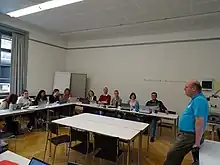Microhistory
Microhistory is a genre of history that focuses on small units of research, such as an event, community, individual or a settlement. In its ambition, however, microhistory can be distinguished from a simple case study insofar as microhistory aspires to "[ask] large questions in small places", according to the definition given by Charles Joyner.[1] It is closely associated with social and cultural history.

Origins
Microhistory became popular in Italy in the 1970s.[2] According to Giovanni Levi, one of the pioneers of the approach, it began as a reaction to a perceived crisis in existing historiographical approaches.[3] Carlo Ginzburg, another of microhistory's founders, has written that he first heard the term used around 1977, and soon afterwards began to work with Levi and Simona Cerutti on Microstorie, a series of microhistorical works.[4]
The word "microhistory" dates back to 1959, when the American historian George R. Stewart published Pickett's Charge: A Microhistory of the Final Attack on Gettysburg, July 3, 1863, which tells the story of the final day of the Battle of Gettysburg.[5] Another early use was by the Annales historian Fernand Braudel, for whom the concept had negative connotations, being overly concerned with the history of events.[6] A third early use of the term was in the title of Luis González's 1968 work Pueblo en vilo: Microhistoria de San José de Gracia.[6] González distinguished between microhistory, for him synonymous with local history, and "petite histoire", which is primarily concerned with anecdotes.[6]
Approach
The most distinctive aspect of the microhistorical approach is the small scale of investigations.[2] Microhistorians focus on small units in society, as a reaction to the generalisations made by the social sciences which do not necessarily hold up when tested against these smaller units.[7] For instance, Ginzburg's 1976 work The Cheese and the Worms – "probably the most popular and widely read work of microhistory"[2] – investigates the life of a single sixteenth-century Italian miller, Menocchio. The individuals microhistorical works are concerned with are frequently those whom Richard M. Tristano describes as "little people", especially those considered heretics.[8]
Carlo Ginzburg has written that a core principle of microhistory is making obstacles in sources, such as lacunae, part of the historical account.[9] Relatedly, Levi has said that the point of view of the researcher becomes part of the account in microhistory.[10] Other notable aspects of microhistory as a historical approach are an interest in the interaction of elite and popular culture,[11] and an interest in the interaction between micro- and macro-levels of history.[12]
See also
- Alltagsgeschichte
- English local history
- History from below
- Category:Microhistorians
- Macrohistory
Notable microhistorians
- Wolfgang Behringer
- Jaroslav Čechura
- Simona Cerutti
- Alain Corbin
- John J. Curry
- Robert Darnton
- Natalie Zemon Davis
- Arie van Deursen
- Clifford Geertz
- Carlo Ginzburg
- Luis González y González
- Maurizio Gribaudi
- Craig Harline
- Cynthia A. Kierner
- Mark Kurlansky
- Emmanuel Le Roy Ladurie
- Giovanni Levi
- Sigurður Gylfi Magnússon
- Luis Mott
- Leslie Peirce
- Detlev Peukert
- Osvaldo Raggio
- Jacques Revel
- Guido Ruggiero
- David Sabean
- Mimi Sheller
- Jonathan D. Spence
- Alan Taylor
- Stella Tillyard
- E. P. Thompson
- Alfred F. Young
- Carolyn Steedman
- Laurel Thatcher Ulrich
- Robert Bickers
- Sue Peabody
References
- Joyner, Charles W. (1999). Shared Traditions: Southern History and Folk Culture. Urbana: University of Illinois. p. 1.
- Tristano 1996, p. 26.
- Burke 1991, p. 93-94.
- Ginzburg, Tedeschi & Tedeschi 1993, p. 10.
- Ginzburg, Tedeschi & Tedeschi 1993, p. 11.
- Ginzburg, Tedeschi & Tedeschi 1993, p. 12.
- Magnússon, Sigurdur Gylfi (2003). "'The Singularization of History': Social History and Microhistory within the Postmodern State of Knowledge". Journal of Social History. 36 (3): 709. doi:10.1353/jsh.2003.0054. S2CID 144942672.
- Tristano 1996, p. 26-27.
- Ginzburg, Tedeschi & Tedeschi 1993, p. 28.
- Burke 1991, p. 106.
- Tristano 1996, p. 28.
- Tristano 1996, p. 27.
Bibliography
- Burke, Peter (1991). "On Microhistory". In Levi, Giovanni (ed.). New Perspectives on Historical Writing. Cambridge: Polity Press. p. 254. ISBN 9780271008271 – via Google Books.
- Ginzburg, Carlo; Tedeschi, John; Tedeschi, Anne C. (1993). "Microhistory, Two or Three Things That I Know about It". Critical Inquiry. The University of Chicago Press. 20 (1): 10-35. doi:10.1086/448699. JSTOR 1343946. S2CID 197852979.
- Künzel, Geraldien von Frijtag Drabbe; Galimi, Valeria (2019). "Microcosms of the Holocaust: Exploring New Venues into Small-Scale Research of the Holocaust". Journal of Genocide Research. 21 (3): 335–341. doi:10.1080/14623528.2019.1631517.
- Tristano, Richard M. (1996). "Microhistory and Holy Family Parish: Some Historical Considerations". U.S. Catholic Historian. Catholic University of America Press. 14 (3, Parishes and Peoples: Religious and Social Meanings, Part Two): 23-30. JSTOR 25154561.
External links
- Microhistory - The website of the Center for Microhistorical Research at the Reykjavik Academy in Iceland.
- "What is Microhistory?", Sigurdur Gylfi Magnusson, chair of the Center for Microhistorical Research
- Microhistory Network A group of historians interested in microhistory (2007-)